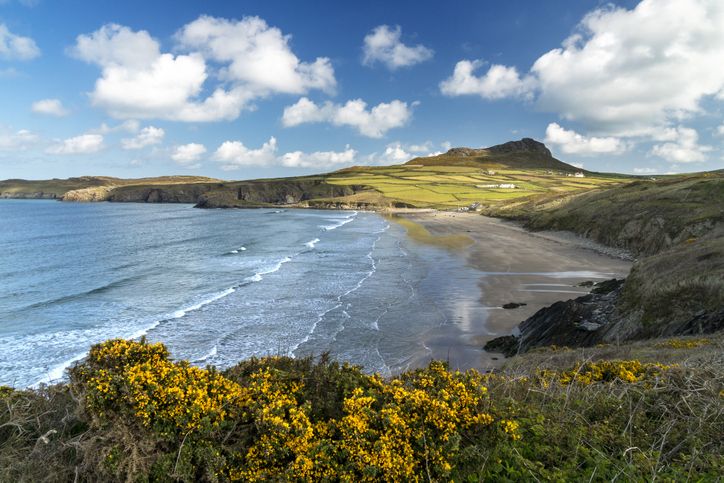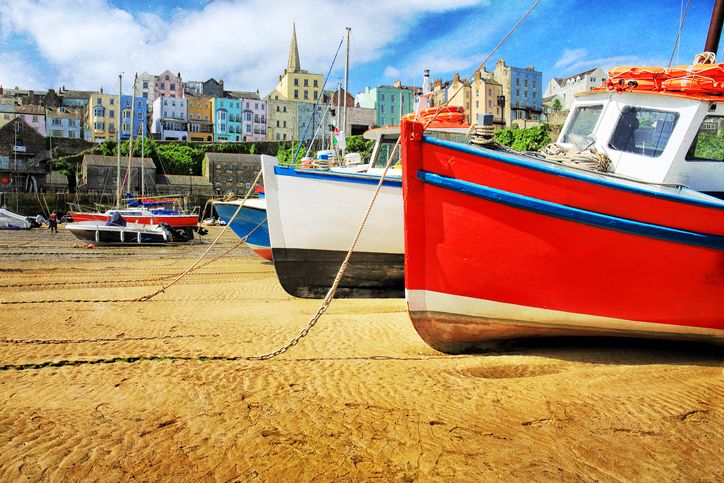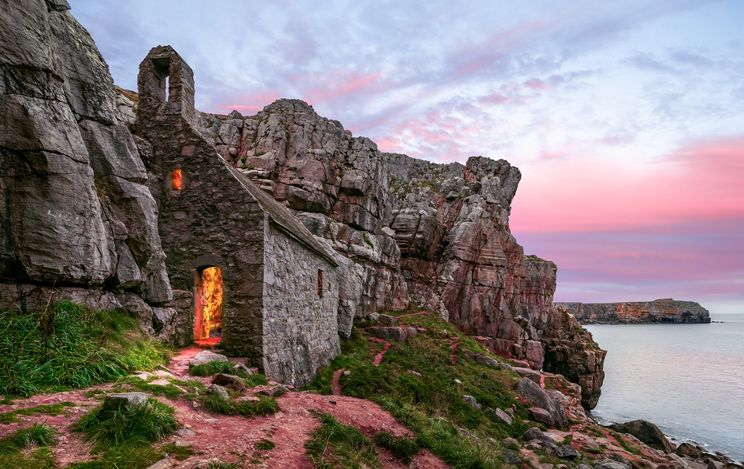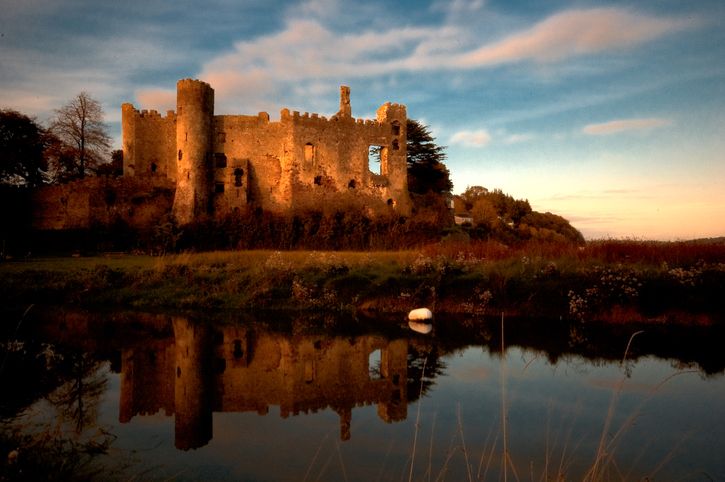
Steps down to St David's Cathedral, St David's, Pembrokeshire, WalesGetty Images
Sunshine or showers, there’s always lots to see and do in Pembrokeshire, on the Welsh coast.
In the south of the county, Pembroke Castle towers over the small riverside town of Pembroke, where you’ll find a gorgeous delicatessen, cosy cafes, a medieval parish church, a heritage museum, and a virtual reality gaming centre.
The Pembroke River flows right past the castle, and as you head inside the ruined fortress, if you’re lucky, there’ll be a living history event to bring the experience to life.
When we visited, 14th-century warriors were demonstrating medieval warfare techniques on the lawns. Tour guides relayed stories about the castle’s defences and provided insight to its many sieges.

Whitesands beach and Carn Llidi on the Pembrokeshire coast path by St Davids - stock photo
The history
The castle was built in 1189 by William Marshall, the 1st Earl of Pembroke. It replaced an earlier wooden fortress on the same site and was expanded and strengthened by William’s son, Gilbert. When the line of inheritance eventually died out in 1389, the Castle became the property of The Crown. In 1452, King Henry VI gave the Castle and the Earldom to his half-brother Jasper Tudor. Jasper brought Margaret Beaufort, his widowed sister-in-law, to the Castle and in 1457 she gave birth to the child who later became King Henry VII of England.
During the English Civil War, the Castle was besieged and claimed by both sides. Eventually, in 1648, Oliver Cromwell led his forces into a seven-week siege. They won the battle and he ordered the destruction of the castle, encouraging locals to take the stones away for use in their own building projects.
The ruined castle was then abandoned until 1880 when a three-year project preserved what was left, stopping it from falling into further disrepair. In 1928, a new owner Major-General Sir Ivor Philipps restored the walls, gatehouses, and towers. After he passed away, a Trust was set up to secure the castle’s future as a heritage site.
Walk around the castle today and you’ll see rooms recreated in the style of the 14th century. Living history groups give cookery demonstrations at weekends. They re-enact battles with sword fights, archery, and explain battle tactics used back in the day. There are even displays of 14th-century fashion.
One of the most interesting and unusual things about the castle is that it was built over a huge cave, which was once occupied by Neolithic people. Follow steps from the ruins of the Great Hall into the subterranean chamber below, and you’ll be amazed by the size of this vast cavern. Listen for the bats squeaking high above your head!
When you’ve finished exploring the castle, a short journey east will bring you to Colby Woodland Garden, a lovely floral garden surrounded by woodland. There are eight acres to explore. Walk along the terraces, peek inside the summer house, and admire the glorious flower beds. Take a stroll alongside the stream and walk through the woodlands. It’s a lovely relaxing place, with a cafe, second-hand book shop, and some unusual varieties of trees.
Read more
Tenby
One of the most popular holiday destinations in Pembrokeshire is Tenby, on the south coast. It has a good mix of indoor and outdoor attractions, a long sandy beach, and is close to Caldey Island. The Tudor House Museum in the heart of Tenby immerses visitors in the lives of a Tudor family. This old merchant’s house has a servants’ kitchen, a living area, and a bedroom, all decked out with Tudor style furnishings. Apparently, the Tudors slept sitting up because they believed that if they laid down their mouths would fall open and the devil would enter them. The family who lived here managed to fit a family of six in one double bed because they all slept sitting up, so we’re told. They wrapped the baby in swaddling clothes and hung him from the wall to sleep.
Picturesque Tenby Harbour is a hive of activity with lifeboat cruises and private yachts coming and going. It’s also home to the fisherman’s church, which was funded by the parishioners of the parish church at Tenby, because they were offended by the smell of the fishermen.
Just above the long sandy beach stands Tenby Museum & Art Gallery, with many displays exploring local history and culture. One room looks at the history of Tenby as a holiday resort and its naughty postcards. The company that produced the postcards was taken to court 159 times on charges of indecency. The World War I exhibition is good too, with a graphic account of life in the trenches, as well as information about the process of recruitment into the forces, women’s roles, and the Land Army. You can see prehistoric artefacts found on Tenby and its islands, including teeth from a woolly mammoth, and learn about the rise and fall of local industries - for example, the oyster industry was destroyed by over-fishing.

Colourful fishing boats moored up on the beach in Tenby at low tide.
Caldey Island
Just across the water from Tenby is Caldey Island, a monastic island with a small community of Cistercian monks living lives of simplicity in a former Benedictine monastery. Ferries leave regularly from Tenby North Beach, between April and October. Walk from the jetty at Caldey Island to the village centre, where the monastery towers over the green. A path leads to the lighthouse and then takes you on a walk around the coast. From here, you’re immersed in a wonderful natural landscape, surrounded by wildlife. Seals swim in the sea and you might see puffins in the spring and early summer. The views are excellent, and there’s a woodland walk through an area that is home to red squirrels.
Back in the village, visitors can explore the remains of the Old Priory, visit the chocolate shop, the cafe, and read about the monks’ way of life in the museum. In addition to the monks, about 25 other people live on the island, some of whom work for the monastery. You can visit the monastery church and the parish church, but the monastery itself is closed to visitors.
Walk up the hill to ‘Calvary’, where a cross stands on a peak, with a carved sculpture of Jesus nailed to it. This is a place for quiet thought and contemplation. Head back downhill to the beach, where swathes of glorious golden sands await you. From here, you can watch boats travelling between Tenby and Caldey island.
Back on the British mainland, Stackpole Estate, also on the south coast, is worth a visit. It has acres of woodlands, lakes, walled gardens, and coastal walks. The scenery is amazing, with some dramatic examples of coastal erosion, including great holes in the landscape, where sea-caves have collapsed leaving big holes in the cliffs.
The lakes at Stackpole were created by damming natural springs and streams. Now they’re home to a variety of wildlife, and you might see otters if you’re there at dawn, as well as the dragonflies and water birds enjoying the water. There was once a house on the land at Stackpole, but it was requisitioned during WWII as military barracks. It fell into disrepair, thieves stole the lead off the roof, and it developed a serious water, damp, and mould problem, so it was eventually demolished.
On the walk around Stackpole Estate, you come to Stackpole Quay, with its beach and popular cafe. You can see different rocks as they meet on a faultline that runs through the Quay.
On the west coast of Pembrokeshire at Angle, is Chapel Bay Fort and Museum. This 19th-century fortress served during both world wars and was fitted with anti-aircraft guns in WWII, but despite its readiness, the fort never saw any action.
Today it’s run as a historic fort and museum. It houses an impressive collection of weaponry and bombs, dating from the 18th century to the present day. Some of the weapons on display were only recently decommissioned. Other models are still in use, which for me, made this museum particularly fascinating and unusual. Fans of action movies and war films will probably recognise some of the guns and grenades. Anyone with a background in the military is bound to recognise some of the equipment.

Afterglow, St Govan's chapel, Stackpole, Pembrokeshire, Wales.
There are cannons, decommissioned explosives, mines, and an armoured vehicle, as well as an impressive collection of shells, torpedoes, and missiles. The guided tour takes you around parts of the fort that are closed to museum visitors. You also see sheds housing larger vehicles and guns in the collection. Some of the military vehicles have been restored from rusty old artefacts to shiny functional machines. There’s even an 18th-century fire pump, beautifully restored and painted bright red.
The collection belongs to George Geear, who collected the artefacts over many years, housing them in sheds, until the opportunity to buy this old fort came up. The site was derelict and a terrible mess, but he got planning permission to turn the officers’ mess into a two-storey house and the rest is history. He now lives in the former officers’ mess, surrounded by his passion: a historic fort, full of fantastic artefacts from his military collection.
Travel north to find more stunning coastal landscapes. At Marloes Peninsula you’ll find beaches and wetlands, craggy rocks, and brilliant sea views. The Peninsula has a shop, cafe, and boat rides are available. Look out for the islands of Skomer, Midland Isle, and Skokholm. You may see seals resting on the beaches below the cliffs. The Peninsula offers a charming landscape with lots of birds and wildlife.
Travel a little further north to the popular coastal resort of St David’s, where the 12th-century cathedral is free to explore. See the glorious interiors, sumptuous decor, and don’t miss the Lady Chapel with its ornate vaulted ceiling and coats of arms embedded in the woodwork.
The Pembrokeshire Coast Path at St David’s offers beautiful views of the ragged coastline. Keep your eyes peeled for seals or dolphins. St David’s Lifeboat Station at St Justinians is open to the public between April and October. From the adjacent Old Lifeboat Station you can take a ferry to Ramsey Island or join a wildlife cruise.
The shopping centre at St David’s has gift shops, a speciality food store, and a National Trust visitor centre. Visit St David’s Peninsula for more amazing landscapes and sea views. The area is rich with wildlife, including birds and insects.
While staying in Pembrokeshire, you could visit a few attractions in the neighbouring county of Carmarthenshire. Pendine Sands on the south coast is famous for its land speed records, particularly Sir Malcolm Campbell’s record-breaking speeds in his Bluebird car in the 1920s. A new ‘Sands of Speed’ museum is being built at Pendine Sands, replacing the now demolished ‘Museum of Speed’. The new attraction is expected to open in the summer of 2020. Speed events continue to take place on the beach and in 2018 Kevin Nicks broke his own record in a motorised shed, reaching 101mph. In April 2019, Zef Eisenberg averaged 182.4 mph over two miles, setting a new record on his Suzuki Hayabusa motorbike.
Nearby Laugharne Castle was built by the Normans in 1215, replacing an earlier fortification on the site. In 1584, Elizabeth I gave the castle to Sir John Perrott, the illegitimate son of Henry VIII. He turned the dilapidated castle into an impressive residence with a Grand Hall. However, a series of unfortunate events led to him ending up incarcerated in the Tower of London, following allegations of treason. He died before he could be executed, possibly from poison.
Today Laugharne Castle is a ruin, but it’s often visited by living history groups at weekends. Weapons demonstrations, battle tactics, archery, and crafts are all designed to educate and inform visitors while helping to bring history to life.

Laugharne Castle and sunset
* Originally published in April 2020. Updated in 2023.





Comments